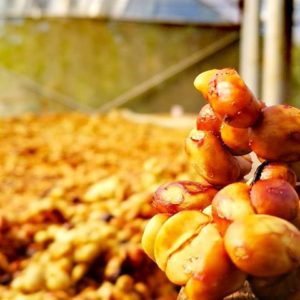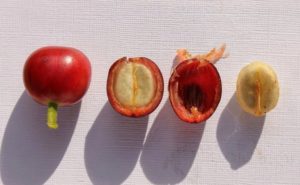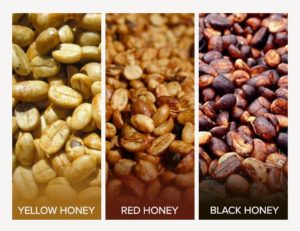
No, I’m not talking about people who add honey to their coffee, and even less about adding artificial flavours in ours. I’m really talking about a naturally honeyed coffee through the Honey Process! But what is the “Honey Process”?
Let’s Start at the Beginning
Coffee beans come from cherries, that come from a tree called, simply enough, the coffee tree. In this cherry, we usually find 2 seeds, which are in fact 2 coffee beans. I say usually because for the Tanzania Peaberry, there is only one! And like the majority of stone fruits, this coffee cherry contains mucilage. This is where it becomes interesting!
The Different Processes
 Once the coffee cherries are harvested, they must go through a transformation process before they can be consumed as coffee beans. Producers use various methods to liberate the bean from the cherry. The most commonly known are natural/dry processing, washed processing and Honey processing. The coffees you are most used to buying are predominantly washed coffees. What’s the difference? Let’s go over them quicly:
Once the coffee cherries are harvested, they must go through a transformation process before they can be consumed as coffee beans. Producers use various methods to liberate the bean from the cherry. The most commonly known are natural/dry processing, washed processing and Honey processing. The coffees you are most used to buying are predominantly washed coffees. What’s the difference? Let’s go over them quicly:
- Washed processing: The coffee cherries have their pulp removed, leaving the mucilage in place, then they are washed and soaked in pools of water (SWP, MWP, etc.) for 12 to 36 hours. The beans have a final wash to remove the mucilage and then are set out to dry.
- Dry/natural processing: The coffee cherries, unaltered, are set out to dry in the sun for several days and raked regularly to ensure they dry evenly.
- Honey processing (semi-washed): Consists of washing and pulping the coffee cherries, leaving some mucilage on the bean. They are then set out to dry in the sun with their mucilage, becoming sticky like honey, thus the name.
Honey processing is a hybrid process, between washed and natural, where the producer voluntarily leaves a variable amount of mucilage, to then leave the bean to dry in the sun for up to 20 days. This process is more expensive to produce, because it requires more time, more adequate installations and more workers to rake the beans, but it allows for delicate notes of sweetness to come through. The natural sweetness of the fruit is enhanced beautifully. These coffees are often from micro lots, therefore only available in small quantities, they are also well processed and of very high quality.
What is Honey Processing?
To get to the bean, you must go through roughly 4 layers: the pulp, the mucilage, the parchment, the silver skin and finally, the coffee bean. We start by delicately peeling off the pulp of the cherry, taking great care in leaving a layer of mucilage. The amount of mucilage left on the bean will determine its colour at the end of the drying process:
- YELLOW HONEY if it’s a thin layer (about 50 % of the mucilage) and the beans will be turned every hour
- RED HONEY if the layer is a bit thicker (about 75% of the mucilage) and the beans will be turned many times in a day
- BLACK HONEY if it’s a thick layer (as much mucilage as possible) and the beans will be turned only once a day
So what?
The more mucilage there is on the bean, the more time it will spend in the sun. During this fermentation process, the natural sugars contained in the mucilage, caramelize in the sun and get gently absorbed within the bean. The green coffee beans then take on a golden hue, that can go from yellow to red to black. Once the drying process is done, we wash the beans in fresh water to remove any impurities. This processing method will impart more sweetness, more liveliness and a distinct fruity note on the green coffee beans, making it a very different cup from coffees washed the usual way and less acidic than coffees that have been dry processed.
This method of processing was perfected in Costa Rica, particularly after the 2008 earthquake that sent the country into an extreme water shortage, leaving coffee producers scrambling. How could they process their coffee without water? In search of an alternative solution in this time of crisis, producers looked at Africa and Brazil, how they had adapted techniques that did not require water and decided to try them, with a few modifications of their own. In fact, this innovation helps producers who are mindful about reducing their water consumption, since this process allows them to save 3 gallons of water per pound, compared to the traditional washing method.
Lastly, did you know that Costa Rica provides less than 1% of the world’s coffee on the market? That’s not much! So, like us, it’s important for coffee producers to find a way to stand out and get noticed. We must admit, Honey Processing is certainly a step in the right direction, because it has undeniably piqued our curiosity and most probably yours too! So what are you waiting for, try our Yellow & Red Honey blend from Costa Rica!?

